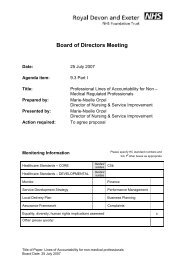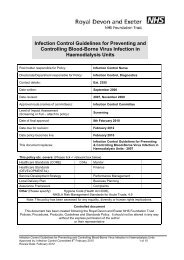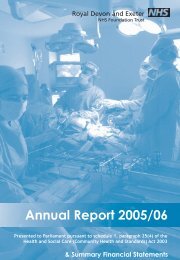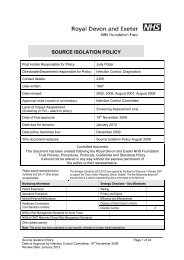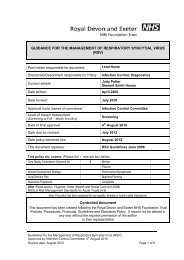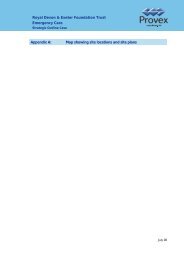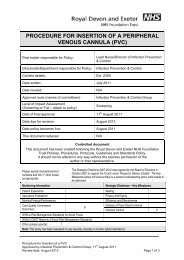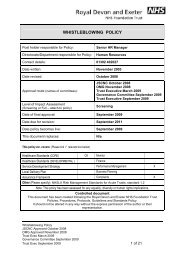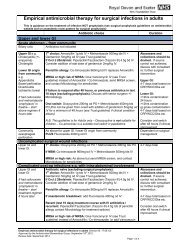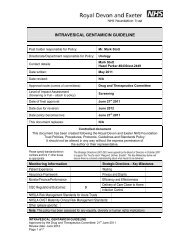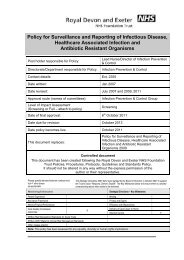Annual Report and Accounts 2012/13 - Royal Devon & Exeter Hospital
Annual Report and Accounts 2012/13 - Royal Devon & Exeter Hospital
Annual Report and Accounts 2012/13 - Royal Devon & Exeter Hospital
You also want an ePaper? Increase the reach of your titles
YUMPU automatically turns print PDFs into web optimized ePapers that Google loves.
1. ACCOUNTING POLICIES (CONTINUED)<br />
1.15 Financial instruments <strong>and</strong> financial liabilities (continued)<br />
Loans <strong>and</strong> receivables<br />
ROYAL DEVON AND EXETER NHS FOUNDATION TRUST - ANNUAL ACCOUNTS <strong>2012</strong>/<strong>13</strong><br />
Loans <strong>and</strong> receivables are non-derivative financial assets with fixed or determinable payments that are not quoted in an active<br />
market. They are included in current assets.<br />
The Trust’s loans <strong>and</strong> receivables comprise: cash <strong>and</strong> cash equivalents, NHS receivables, accrued income <strong>and</strong> ‘other<br />
receivables’.<br />
Loans <strong>and</strong> receivables are recognised initially at fair value, net of transactions costs, <strong>and</strong> are measured subsequently at<br />
amortised cost, using the effective interest method. The effective interest rate is the rate that discounts exactly estimated future<br />
cash receipts through the expected life of the financial asset or, when appropriate, a shorter period, to the net carrying amount<br />
of the financial asset.<br />
Interest on loans <strong>and</strong> receivables is calculated using the effective interest method <strong>and</strong> credited to the Statement of<br />
Comprehensive Income.<br />
Other financial liabilities<br />
Other financial liabilities are recognised initially at fair value, net of transaction costs incurred, <strong>and</strong> measured subsequently at<br />
amortised cost using the effective interest method. The effective interest rate is the rate that discounts exactly estimated future<br />
cash payments through the expected life of the financial liability or, when appropriate, a shorter period, to the net carrying<br />
amount of the financial liability.<br />
They are included in current liabilities except for amounts payable more than 12 months after the statement of financial position<br />
date, which are classified as non-current liabilities.<br />
Interest on financial liabilities carried at amortised cost is calculated using the effective interest method <strong>and</strong> charged to finance<br />
costs. Interest on financial liabilities taken out to finance property, plant <strong>and</strong> equipment or intangible assets is not capitalised as<br />
part of the cost of those assets.<br />
Impairment of financial assets<br />
NOTES TO THE ACCOUNTS<br />
At the Statement of Financial Position date, the Trust assesses whether any financial assets are impaired. Financial assets are<br />
impaired <strong>and</strong> impairment losses are recognised if, <strong>and</strong> only if, there is objective evidence of impairment as a result of one or<br />
more events which occurred after the initial recognition of the asset <strong>and</strong> which has an impact on the estimated future cash<br />
flows of the asset.<br />
For financial assets carried at amortised cost, the amount of the impairment loss is measured as the difference between the<br />
asset’s carrying amount <strong>and</strong> the present value of the revised future cash flows discounted at the asset’s original effective<br />
interest rate. The loss is recognised in the Statement of Comprehensive Income <strong>and</strong> the carrying amount of the asset is<br />
reduced through the use of a bad debt provision that is determined specifically on individual assets.<br />
1.16 Corporation tax<br />
The Trust is a Health Service Body within the meaning of s519A of the Income <strong>and</strong> Corporation Tax Act 1988 <strong>and</strong> accordingly<br />
is exempt from taxation in respect of income <strong>and</strong> capital gains within categories covered by this. There is a power for HM<br />
Treasury to dis-apply the exemption in relation to specified activities of an NHS foundation trust (s519A (3) to (8) of the Income<br />
<strong>and</strong> Corporation Taxes Act 1988). Accordingly, the FT is potentially within the scope of corporation tax in respect of activities<br />
which are not related to, or ancillary to, the provision of healthcare, <strong>and</strong> where the profits there from exceed £50,000 per<br />
annum. Until the exemption is dis-applied then the FT has no corporation tax liability.<br />
1.17 Non-current assets held for sale<br />
Non-current assets are classified as assets held for sale when their carrying amount is to be recovered principally through a<br />
sale transaction <strong>and</strong> a sale is considered highly probable. They are stated at the lower of carrying amount <strong>and</strong> fair value.<br />
1.18 Consolidation of NHS charitable funds<br />
The Trust is the Corporate Trustee of the <strong>Royal</strong> <strong>Devon</strong> <strong>and</strong> <strong>Exeter</strong> NHS Foundation Trust General Charity. The Charity has not<br />
been consolidated within these annual accounts as HM Treasury has granted a dispensation to the application of IAS 27 in<br />
relation to the consolidation of NHS charitable funds for <strong>2012</strong>/<strong>13</strong>. Further information relating to transactions between the Trust<br />
<strong>and</strong> the Charity is disclosed in note 25.<br />
Page 17



